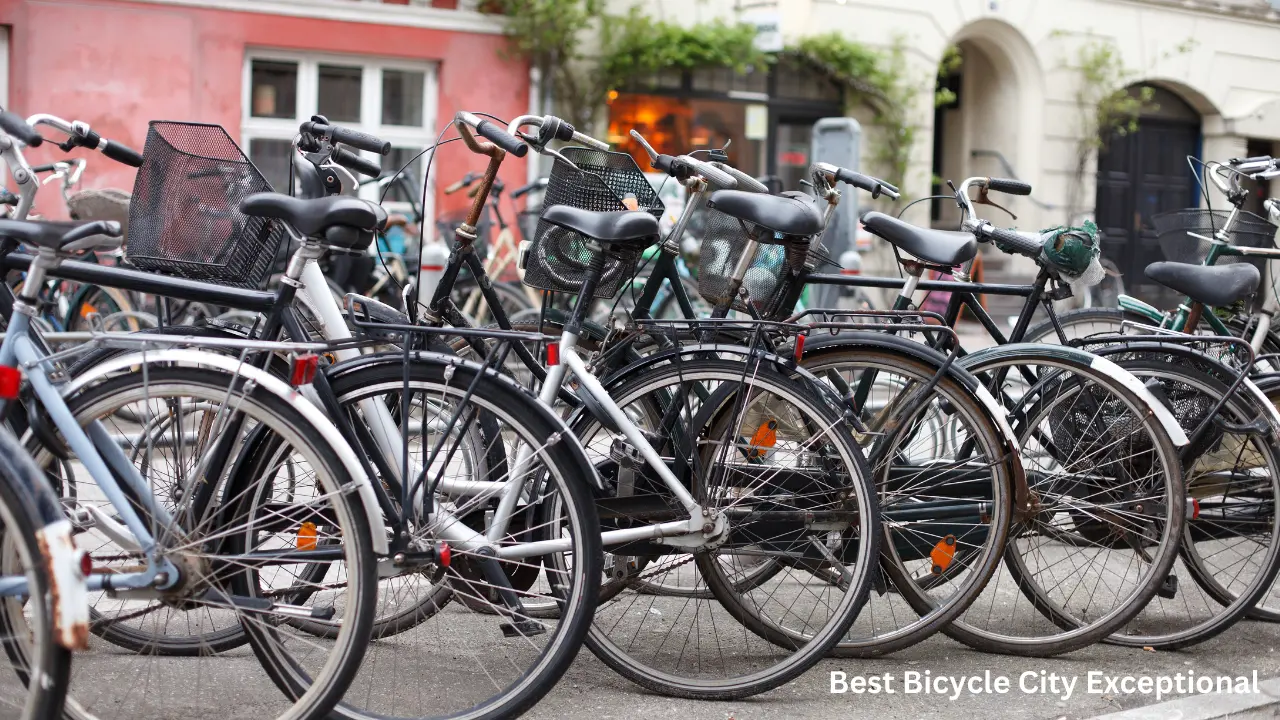Imagine this: you’re strolling through a city, the sun warm on your face, and the only sounds are the gentle whir of wheels and the cheerful chatter of people enjoying their surroundings. Cars are few and far between. This isn’t just a dream; it’s the reality in the world’s best bicycle city. But what makes a city truly exceptional for cyclists? This post will help you explore the elements that transform a city into a paradise for two-wheeled enthusiasts. You’ll gain a thorough comprehension of what constitutes a cycling haven and how cities can be transformed for better transport and lifestyle. Get ready to discover the essential components of a city ideal for cyclists, increasing your knowledge and inspiring your next urban adventure.
Key Takeaways
- Learn the criteria used to evaluate a world’s best bicycle city.
- Discover the key infrastructure elements for excellent cycling.
- Understand how urban planning can favor cycling and reduce traffic.
- Explore the societal benefits of a bike-friendly environment.
- See how communities improve cycling infrastructure.
- Learn about international examples and their approaches.
The 5 Factors of Cycling Excellence
Creating a truly bike-friendly city is more than just adding bike lanes. It’s about designing a comprehensive system that prioritizes cyclists’ safety, convenience, and overall experience. From dedicated infrastructure to city-wide policies, multiple elements combine to make a city ideal for cycling. The approach combines safety, accessibility, and community integration to make cycling a primary means of transport and leisure. The world’s best bicycle city doesn’t just accommodate cyclists; it embraces them. Now, let’s explore the top five components that define the pinnacle of cycling excellence.

1. Dedicated and Well-Maintained Infrastructure
The foundation of any great cycling city rests on its infrastructure. It’s more than just painting lines on the road; it involves a well-designed network that prioritizes safety and convenience. This includes dedicated bike lanes, protected bike paths, and clearly marked routes.
The creation of a comprehensive cycling infrastructure requires deliberate planning and investment. The objective is to design routes that minimize conflicts between cyclists, pedestrians, and automobiles. This means separating bike lanes from car traffic with physical barriers such as bollards, planters, or raised medians, enhancing protection.
Bike Lanes
-
- Protected Bike Lanes: These are physically separated from car traffic, offering the highest level of safety.
Protected bike lanes often include barriers such as concrete dividers, parked cars, or bollards that provide a physical buffer from moving vehicles. This is vital on high-speed roads or those with heavy traffic.
-
- Buffered Bike Lanes: These lanes provide extra space between cyclists and car traffic via a painted buffer.
The buffer gives cyclists more room and alerts drivers of the presence of cyclists. This is a common and often cost-effective way to improve cycling infrastructure.
-
- Shared Bike Lanes (Sharrows): These indicate to both cyclists and drivers where cyclists should be riding.
Shared bike lanes, with or without markings, are often used on streets with lower traffic volumes, providing guidance and reminding drivers to share the road.
-
- Bike Paths: Separate paths that are exclusively for cyclists, and often pedestrians.
Bike paths are ideal for commuting or leisure and can run alongside roads, rivers, or through parks. They ensure a safe and enjoyable riding experience, away from cars.
Well-maintained infrastructure also means regular upkeep. This involves consistently cleaning bike lanes, fixing potholes, and providing clear signage. Lighting is also crucial, especially in areas with limited sunlight. Good lighting makes cycling safer and more appealing, making nighttime riding safer.
Example: In Copenhagen, Denmark, the extensive network of protected bike lanes and bridges over major roads are designed to ensure cyclists can travel quickly and safely throughout the city. This commitment to infrastructure encourages cycling and lowers traffic congestion, resulting in cleaner air.
Statistic: According to a study by the European Cyclists’ Federation, cities with well-developed cycling infrastructure see a 20% to 30% decrease in cyclist-related accidents.
2. Urban Planning and Design
Urban planning plays a huge role in supporting a cycling-friendly environment. Thoughtful design can integrate cycling into the city’s fabric, reducing the need for cars and promoting sustainable transport.
A central element of urban planning is creating a connected network of bike routes. These routes should link residential areas, workplaces, schools, and recreational spots. This ensures that cycling becomes an accessible and practical transport option for various daily activities.
Key Design Features
-
- Traffic Calming Measures: These measures, such as speed bumps, roundabouts, and narrowed streets, make roads safer for cyclists by slowing down traffic.
Traffic calming measures help make streets safer for all users, including cyclists and pedestrians, making areas safer and more inviting.
-
- Bike Parking Facilities: Providing convenient and safe bike parking is essential. This includes secure bike racks at public locations and storage spaces at home and in the workplace.
When there are adequate and convenient bike parking options, people are more likely to cycle. Secure facilities protect bikes from theft and weather conditions, while parking at key places encourage cycling.
-
- Mixed-Use Development: Mixed-use areas are designed so people can live, work, and shop in the same area. This reduces the need for long car trips.
Mixed-use development makes areas more pedestrian-friendly and conducive to cycling. By combining different functions in a single area, the city reduces traffic and promotes a sense of community.
-
- Greenways and Parks: Integrating green spaces and parks provides pleasant cycling routes and encourages recreational use.
Greenways and parks offer attractive, car-free cycling paths and provide opportunities for relaxation and exercise. They add to the quality of life in a city and enhance its cycling appeal.
Beyond physical infrastructure, urban planning also includes implementing policies that prioritize cycling. This includes limiting car access in certain areas, setting speed limits, and promoting public transport to complement cycling.
Example: In Amsterdam, Netherlands, the city’s design incorporates canal-side bike paths and pedestrian zones, which prioritize cyclists. It makes cycling a simple and enjoyable mode of transport. The result is a vibrant city where bikes are an integral part of daily life.
Scenario: Imagine a new housing development that includes a protected bike lane leading directly to a nearby business district. This would greatly reduce the commute time and encourage more people to choose cycling over driving.
3. Policies and Regulations
Effective policies and regulations are fundamental to making a city bike-friendly. They ensure that cycling is a safe, accessible, and attractive option for all residents. They create a framework that supports and encourages cycling.
Safety regulations are critical. These may include mandating the use of helmets, setting speed limits for cyclists, and enforcing traffic laws that protect cyclists. Enforcing these laws by implementing speed controls, traffic monitoring, and issuing fines for infractions increases safety for cyclists.
Key Policies
-
- Traffic Calming Measures: Speed limits, road closures, and traffic management systems help ensure cyclists’ safety.
Implementing speed limits, road closures, and traffic management systems on roads where cyclists share space with vehicles helps protect cyclists.
-
- Bike-Sharing Programs: Offering bike-sharing programs makes bikes readily available for residents and tourists.
Bike-sharing programs expand cycling access to various parts of the city. Such systems are integrated with public transport, encouraging cycling for short trips or as a final leg in a commute.
-
- Financial Incentives: Subsidies for buying bikes, tax breaks for cycling to work, and funding for cycling infrastructure encourage cycling.
These incentives make cycling an accessible and appealing option, reducing reliance on private cars and promoting cleaner transport.
-
- Education Programs: Education and awareness programs teach people about road safety, cycling etiquette, and the advantages of cycling.
These programs encourage responsible cycling behaviors, increasing the safety and efficiency of cycling for everyone.
Alongside safety regulations, policies supporting cycling access are also essential. These policies involve providing bike parking facilities, promoting integration of cycling and public transport, and enabling cyclists to use public spaces such as trains and buses. This makes it easier for people to combine cycling with other modes of transport, extending their travel options.
Example: Many cities offer financial incentives, such as tax breaks or subsidies, to residents who buy electric bikes or use their bikes for commuting. This financial support reduces the initial cost of cycling and motivates more people to choose cycling over driving.
Statistic: Research by the League of American Bicyclists found that cities with strong cycling policies see an average 15% increase in cycling rates within three years of implementing such policies.
4. Community and Culture
A thriving cycling culture is critical for the long-term success of any bike-friendly city. It fosters a sense of community among cyclists, encourages cycling participation, and normalizes cycling as a usual form of transport and leisure. This involves events, clubs, and organizations that engage and support cyclists.
Community events play a major role in developing a cycling culture. These can include organized group rides, cycling festivals, and educational workshops. Such activities bring cyclists together, promote cycling, and enhance a sense of community.
Cultural Elements
-
- Cycling Clubs and Groups: Cycling clubs provide opportunities to connect with other cyclists.
Cycling clubs and groups organize group rides, social events, and advocacy efforts, fostering a supportive community.
-
- Cycling Advocacy Groups: These groups work to represent cyclists’ interests, advocate for improved infrastructure, and educate the public on the advantages of cycling.
Advocacy groups are essential for raising the profile of cycling issues and promoting the development of bike-friendly policies.
-
- Cycling Events and Festivals: These events increase cycling awareness, bring the community together, and celebrate cycling.
Festivals offer opportunities for cyclists to participate in races, workshops, and social gatherings, cultivating a cycling spirit.
-
- Public Art and Design: Incorporating public art related to cycling can make the city more attractive and celebrates the city’s cycling culture.
Public art enhances the city’s visual appeal and showcases the significance of cycling, which enhances the community’s cycling spirit.
Promoting cycling as a lifestyle through media campaigns, social media, and local publications helps to normalize cycling and encourage participation. This can involve highlighting the advantages of cycling, showing cyclists’ success stories, and providing tips for cycling.
Example: In cities like Portland, Oregon, community-led cycling events, such as group rides and bike-themed festivals, are very common. These events not only provide opportunities for cyclists to connect and have fun but also boost the popularity of cycling within the local area.
Scenario: Imagine a city that hosts regular “Bike to Work” days, with free breakfasts at key intersections and prizes for participants. These initiatives encourage many more people to begin cycling and see it as a normal part of their day.
5. Environmental Considerations
The environmental advantages of cycling are essential to the concept of a bike-friendly city. By promoting cycling, cities can greatly reduce their carbon footprint, improve air quality, and help promote environmental sustainability. This requires integrating cycling into the city’s environmental policies and sustainability goals.
Encouraging cycling helps to reduce the number of cars on the road, which helps to cut down on greenhouse gas emissions and improves air quality. Many cities promote cycling as part of their strategy to combat climate change, setting goals to reduce car dependence and boost the use of alternative means of transport.
Key Environmental Strategies
-
- Reduced Car Traffic: By promoting cycling, cities decrease the demand for car parking. This allows more urban space to be used for green areas and public amenities.
Reduced car traffic leads to more space for pedestrians, cyclists, and green spaces, improving the urban environment and making cities more attractive and liveable.
-
- Sustainable Urban Planning: Urban planning promotes cycling and makes cities more sustainable through reduced pollution.
Sustainable urban planning integrates cycling and promotes efficient use of resources and reduces waste. This includes prioritizing mixed-use developments, providing bike infrastructure, and investing in green spaces.
-
- Green Initiatives: Environmental strategies include promoting electric bikes, organizing bike-sharing programs, and offering incentives for cycling to work.
Offering incentives, promoting electric bikes, and launching bike-sharing programs promotes cycling. They assist with achieving environmental goals, reduce greenhouse gas emissions, and enhance urban health.
-
- Education on Environmental Benefits: Educational campaigns raise awareness about the environmental advantages of cycling.
Promoting cycling’s environmental benefits promotes awareness, inspires individual actions, and aids in broader efforts to make cities sustainable and healthy.
Cities can enhance their environmental standing by supporting cycling and implementing green initiatives. This involves launching electric bike programs, offering incentives for cycling to work, and integrating cycling with public transport. These initiatives assist in reducing pollution, promoting cleaner transport, and creating healthier communities.
Example: In cities like Freiburg, Germany, where cycling is an integral part of life, reduced car dependence has led to a major decrease in air pollution and increased the sustainability of the area. This has contributed to a more vibrant, healthy urban environment.
Statistic: According to a study in the journal “Environmental Health Perspectives,” increased cycling in urban areas can lead to a 10% to 15% decrease in particulate matter and nitrogen oxide pollution.
Common Myths Debunked
Myth 1: Cycling is only for young, fit people.
In reality, cycling is for everyone! With the growth of electric bikes and different types of cycling infrastructure, cycling has become more accessible to people of all ages and fitness levels. Protected bike lanes and cycling routes make the experience safer and more comfortable for everyone, from children to seniors. The benefits of cycling are open to all, regardless of age or physical condition.
Myth 2: Cycling is unsafe, especially in cities.
While cycling does involve some risk, cities are becoming safer by implementing protected bike lanes, traffic calming measures, and clear cycling signage. These safety features reduce accidents. Furthermore, awareness campaigns and education programs help both cyclists and drivers to share the roads. With the appropriate infrastructure and awareness, cycling can be a safe mode of transport.
Myth 3: Cycling is too inconvenient for everyday errands.
Many cities are creating bike-friendly infrastructure with dedicated bike lanes, secure bike parking, and integration with public transport. Cities also have bike-sharing programs. These improvements make cycling easier, and more practical for a variety of tasks. Cycling can often be faster than driving, particularly in urban areas with traffic. Cycling provides flexibility and convenience for daily tasks.
Myth 4: Bike lanes take up too much space and cause traffic congestion.
Well-designed bike lanes can actually help reduce traffic congestion by encouraging people to cycle instead of drive cars. Bikes require less space than cars. As more people choose to cycle, this helps lower traffic volume. Furthermore, the space used for bike lanes is often space that was formerly used for car parking. This promotes better traffic flow overall.
Myth 5: All cities are unsuitable for cycling due to climate.
While climate is a factor, many cities are successfully supporting cycling regardless of weather conditions. Bike-friendly cities are implementing strategies such as covered bike parking, snow removal from bike lanes, and all-weather routes. The use of adaptive cycling gear, such as waterproof clothing, makes cycling comfortable even in adverse conditions. Cycling can be enjoyed year-round.
Frequently Asked Questions
Question: How can I encourage my city to become more bike-friendly?
Answer: Engage with your local government by contacting city councilors, attending public meetings, and supporting local advocacy groups to increase cycling infrastructure. Participate in public input sessions to support cycling projects, and promote cycling by cycling, and show its benefits.
Question: What are the main benefits of cycling?
Answer: Cycling helps improve your health, lowers carbon emissions, improves air quality, and can help to reduce traffic congestion. Cycling saves money, improves health, and can be an easy way to get around the city.
Question: How can I make cycling safer?
Answer: Wear a helmet, follow traffic laws, use lights, and maintain your bike regularly. Ride in bike lanes or designated cycling paths, and make eye contact with drivers. Be alert to your environment and follow traffic signals.
Question: What if my city doesn’t have bike lanes?
Answer: Always obey traffic laws, choose routes with less traffic, and ride in areas that are visible. Join cycling clubs, advocate for changes, and encourage your city government to implement cycling initiatives. Support cycling legislation and cycling-friendly policies.
Question: How do I choose the best type of bike for me?
Answer: Think about the types of journeys you will take, the distances, and the terrain. Road bikes are ideal for speed, while mountain bikes are great for rough terrain. Hybrid bikes are suitable for general use, and electric bikes offer pedal assistance. Try different bikes to see which fits your needs.
Final Thoughts
The journey toward creating a world’s best bicycle city is a continuous endeavor, requiring planning, community engagement, and a commitment to sustainability. From well-designed infrastructure to supportive policies, a city that puts cyclists first can transform the quality of life for all residents. By prioritizing safety, convenience, and environmental responsibility, cities can achieve a future where cycling is not just a form of transport but a fundamental part of urban life. Encouraging cycling provides benefits for individuals and the environment.



